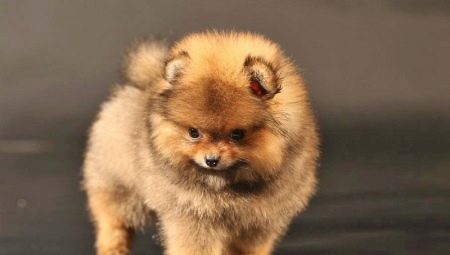Most breeders involved in raising dwarf dogs have a special attention to the Pomeranian breed. Many kennels are breeding dogs exclusively with a fox muzzle, and they quite often take prizes at exhibition events. Along with the fox type of oranges, there are other varieties that are gaining more and more popularity every year, namely doll subspecies and mini-dogs that resemble the muzzle of a teddy bear. It is such kids in the soul of each person that cause special feelings and emotions.
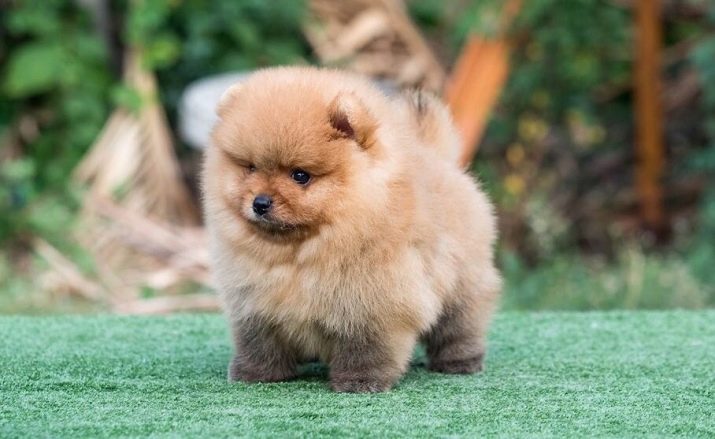
Origin history
Not every breed of decorative dogs boasts such an interesting origin story. The first specimens of the breed described were bred in Pomerania. A distinctive feature of their appearance was snow-white coat color. Until 1700, these dogs were used as guards of private property. After some time, peat dogs with a cute and charming appearance became interested in representatives of the nobility and wealthy families.
Many wealthy ladies began to attend social events accompanied by four-legged friends, similar to cubs. In this way, dwarf dogs began to gain popularity on the European continent. At the same time, dog breeders from different countries were engaged in breeding the representatives of the described breed with the smallest sizes and, through selection, were able to achieve an extraordinary result. They achieved not only the small size of the dog, but also a significant reduction in the body weight of dogs.
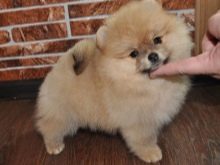
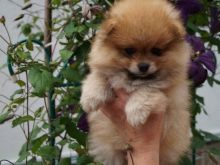
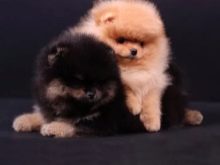
The end of the 18th century for the Pomeranian Spitz breed began the rise of animals from serving commoners to decorating noble houses. Queen Victoria herself, conquered by the external data of oranges, began to acquire representatives of the breed, having the most minimal sizes, around the world. And after some time, she created her own kennel, where she bred decorative mini-cubs.
And only in 1871 England adopted the Oranges as an official breed. Then the fashion for miniature dogs conquered Germany, Holland, France, the USA and Russia. The modern owner of Pomeranian dogs is very difficult to believe that the ancestors of their furry pets were Icelandic and Scottish sled dogs. After all, modern breeders contain dwarf cubs for indoor keeping, breeding or for participating in exhibitions with them.
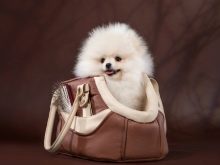
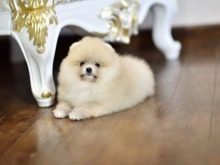
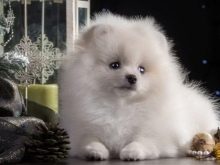
Modern specimens of the breed inherited a temperament from their peat ancestors, thanks to which a strong friendship arises between the owner and owner.
Description
Representatives of this breed have a special physique. The height of the dog at the withers should be identical to the length of the body. Thus, the body of the dog resembles a geometric square. It is quite difficult for an ordinary lover to evaluate these proportions, since all the features of the body are hidden under saturated hair with a thick undercoat. On the neck of the baby there is a magnificent collar of thick, thin and soft hairs, on the hind legs there are small “panties”.
According to the breed standard, the hair of small oranges should be straight and soft to the touch. The ears are small, erect. The tail, like most of the baby’s body, is covered with a delicate fluff. The shape of the hair bends into a ring and fits on the back. In many instances of dwarf spitz, the tail can have two curls.
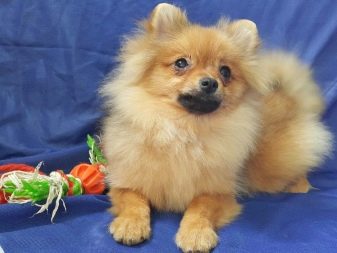
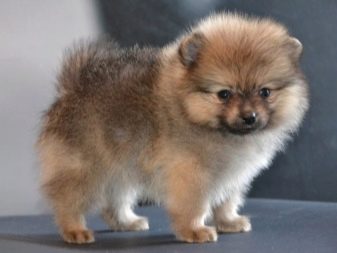
In weight ratio, Pomeranian males are of a bear type. weight from 1.8 to 2.3 kg. Females are characterized by a weight not exceeding 3 kg. With these indicators the growth of males “cubs” should not exceed 22 cm, and the height of the females at the withers should vary from 16 to 20 cm. According to information received from most breeders of oranges, the life cycle of decorative bears is 15 years old, although there have been cases when an animal lived to be 20 years old.

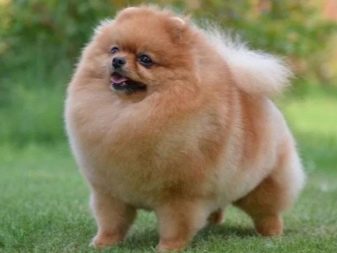
Dog handlers note intellectual data of miniature dogs. They assure that representatives of the decorative breed have a sufficiently lively mind that allows four-legged pets to find a common language with any person. The same factor has a positive effect on the learning of the baby teams and tricks.
It is important to note that The gene of guards is present in the characteristic of Spitzs of a bear type. But judging by the dimensions of the animal, few can believe that representatives of this breed will be able to protect movable or immovable property from someone else’s encroachment. An exceptional pet barking that resembles the voice of large dogs can scare away uninvited guests.
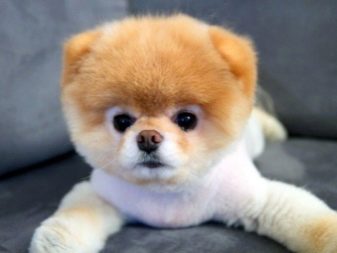
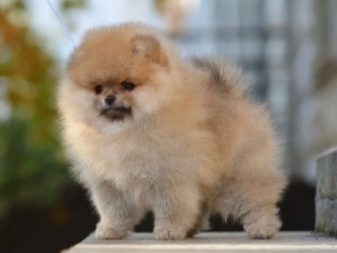
Pomeranian cubs have a fairly fast metabolism. That is why if even a minor ailment occurs in a four-legged friend, its owner should immediately contact a veterinarian for help.
Not every dog lover can afford to get a Pomeranian spitz-dog type. These dwarf babies require special attention and careful care. As a place of residence, they do not have much preference. They adapt quite easily both in the apartment and in a large country house.
Keeping animals on the street is prohibited, despite the fact that the cubs have a warm undercoat that does not allow them to freeze in severe frost. Dwarf oranges must receive a constant load. To do this, it is not enough to play with the dog at home. The kid loses most of his energy on street walks during active games. It is worth noting that walking with an adult dog is necessary in any weather, only a strong sun can be an exception, but in this case too, the animal should be led outside into the shadow zone.
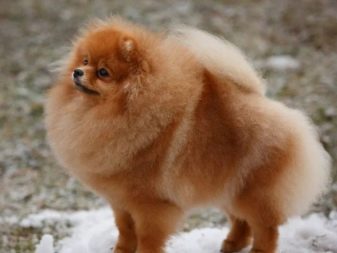
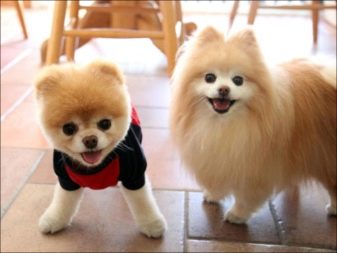
All mini-spitz, regardless of their subspecies and types, are smart creatures, But at the same time may be stubborn and try to dominate the masterif he will express indifference and does not set himself the head in a relationship.
The only difficulty you have to deal with is quite frequent and very loud barking. Weaning a dog from this habit is difficult, but possible. Bear-type oranges, like any miniature dogs, differ in molting wool. In males, this physiological feature occurs twice a year, in females much more often.
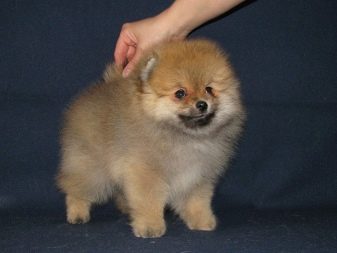
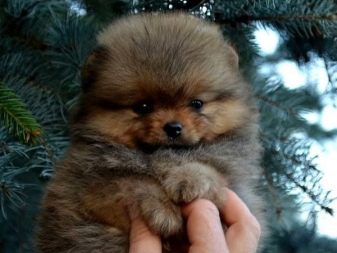
An important aspect due to which parents choose dwarf “cubs” for their children is the four-footed creatures lack aggression towards babies. Nevertheless, for children under the age of seven this is not a suitable pet option.
Of course, a dog is suitable for games, but an adult should be in the role of its owner and educator.
The bear-type Pomeranian is quite comfortable in a large and friendly family. Often they are ready to brighten up the life of a lonely person, if he has time for the maintenance and care of the baby. For people with a busy schedule, which is why they are rarely at home, this breed of dog is not suitable.
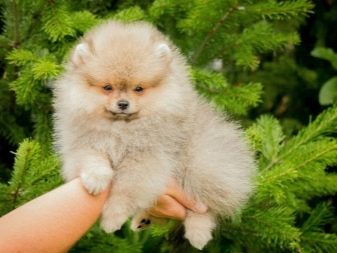
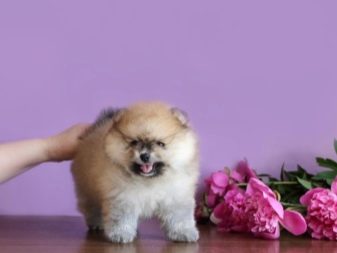
An orange, similar to a teddy bear, differs from his brothers in personality, firmness of character and a charming look. Newly made owners should find a special approach to each fluffy lump.
Body structure
According to the World Association of Cynologists, the Pomeranian Spitz breed has certain standards, according to which animals are evaluated at exhibition events. In appearance, the body of fluffy orange should be proportional. The shape of the body is square. The coat is thick, saturated. The hair on the cheekbones should give a puffy appearance to the cheeks of the dog.
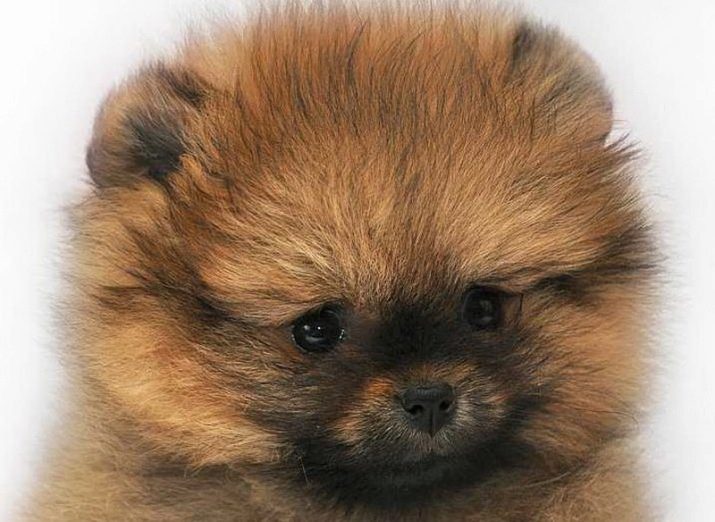
The muzzle of a thoroughbred baby is slightly flattened. The head is miniature, wedge-shaped. The skull of the dog should not exceed medium size. The frontal lobe is rounded, with a smooth transition. The length of the muzzle ranges from 3 to 5 cm. The described subtleties of the body structure are almost invisible, since most of the body is covered with a thick wool coat. In the mouth, according to the standard, 42 teeth should be present.
A scissor bite for exhibits is not a deviation. The nose of the Pomeranian teddy bear is small, black, round and slightly raised up. The eyes are set at a fairly close distance to the nose. Along the contour is a neat black line that any fashionista would envy.


The back of dwarf cubs is short. The straight lumbar zone is quite strong, has small bulges. The abdomen is taut, the neck is slightly elongated. The chest is deep and muscular. Tail of medium length is characterized by increased fluffiness.
The front legs of a bear-type orange are distinguished by pronounced straightness, have a wide frontal line. Muscles stand out on the hind legs. In addition, when examining the hind limbs, straightness of the rack and their parallelism are visible. Due to the characteristics of the limbs, the cubs clearly express their free gait, so that they easily and smoothly move on any surface.
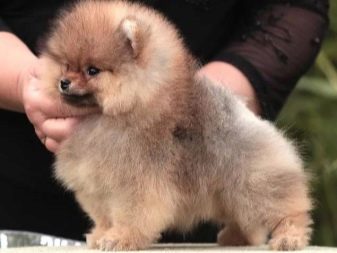
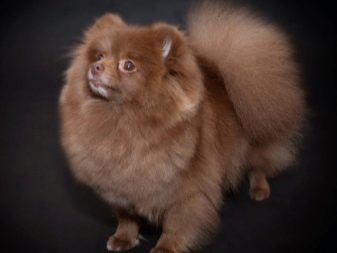
Any features that are not related to the breed standard are a deviation, which indicates culling of the animal.
Color
The woolen coat of the cubs has a huge palette of color options. It can be black, white, chocolate, brown, beige, cream and other colors.But the most common examples are representatives of Pomeranian dogs, endowed with red shades of a fur coat, namely red or fiery. Dwarf cubs of white and black colors are quite rare representatives of the breed. For this reason, their cost significantly exceeds the amount of the puppy with the most familiar color.
Some breeders are sure that if we cross the representatives of the Pomeranian cubs of the same color, we get the same puppies in color. Only this opinion is erroneous. Newborn babies can get the coat color that their great-grandmothers or great-grandfathers were endowed with, which is laid down at the genetic level.
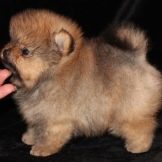
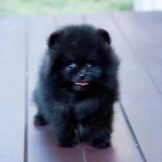
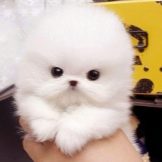
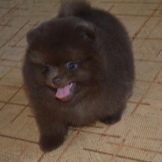
In some cases, puppies born from parents identical in size and color can turn out to be somewhat large, and their coat will be coarse and hard to the touch.
Character
The nature of the decorative cubs is practically no different from the character of standard Pomeranian spitz. These dogs are proud, energetic and very smart creatures. They are always ready to learn the world around them and immediately go on any trip with their owner. Dwarf cubs, by their nature, show a considerable learning ability. Spitz quickly and easily get used to his master’s daily schedule, take his habits, due to which they become full members of the family.
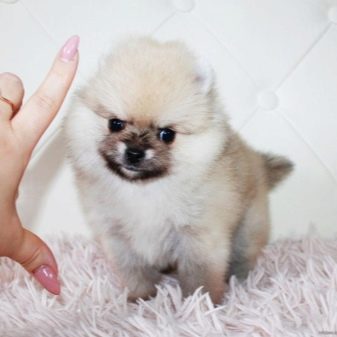

Because of their curiosity, mini-spitz stick their nose into all kinds of holes and nooks. During street walks, they are ready to get acquainted with various plants, insects and animals.
A distinctive feature of their character is self-confidence. They are ready to defend their owner and rush into battle for him, sensing even minimal danger. It doesn’t matter whether it is a branch that fell from the top of a tree, or a large dog that peacefully passes nearby. Dwarf cubs do not show an aggressive attitude towards children. The same applies to animals with which pussies grew from puppyhood.
But if another dog appears on the territory of an adult dwarf teddy bear, a representative of a decorative size gets along with it quite difficult. The same goes for strangers. In some cases, the baby may not easily bark at a stranger, but even bite. The newly-minted owner should stop such actions at the root and, if necessary, punish them.
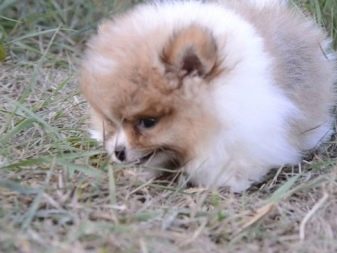

Interesting enough, and in some cases a bad character trait of a dwarf teddy bear is cockiness. It is these fluffy lumps that most often become the instigators of fights with other dogs of any size. At the same time, attacking a formidable opponent, the cubs do not try to hide under the feet of their master. Such actions of the guilty party can lead to the worst ending. For this reason when walking the animal, you must use a leash.
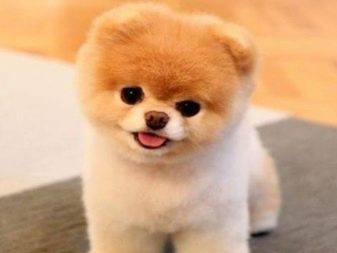
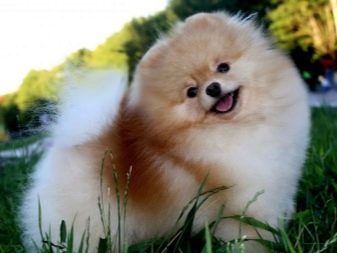
Pros and cons of the breed
The procedure for breeding Pomeranian spitz-dogs of a bear type, as well as any other dog breeds, has a certain list of advantages and disadvantages. Moreover, in this case there are much more pluses than minuses. Breeders themselves are ready to share notes on the positive aspects of keeping dwarf bear babies.
- Thanks to the miniature and unusual appearance of the dog, the owner of the animal will never be left without attention from others. During the walk, children of all ages and adults will be touched by the image of a dwarf teddy bear, and also evaluate the efforts of the owner in maintaining the neat appearance of a miniature pet.
- Each owner assures that these fluffy lumps are the most friendly and cheerful creatures in the world. Thanks to their special face shape, it seems that they are constantly smiling and enjoying life. But if the baby is in a bad mood, even a smiling lip contour will emphasize the dog's drooping mood.
- The playful temperament of dwarf cubs allows them to have fun, get naughty and lead an active lifestyle day and night, which has a very positive effect on families with small children. Surrounded by young hosts, Spitz feel at ease and are ready to explore the world with the children.
- The bear-type Pomeranian is loyal to its owner. They look forward to the arrival of their masters, miss them greatly in their absence. Mini-bears are insanely happy to communicate with any member of the family.
- They are ready to live and accommodate in different environments, easily adapt to any environment. The main thing is that the owner of the dog should be nearby, which means that there should not be any worries.
- Dwarf cubs are quite easily and quickly adapt and adapt to the schedule of all members of their family. They can wake up ahead of time, but they won’t wake a person without urgent need.
- An elegant coat of the baby protects the animal during cold weather and from overheating on hot days. Therefore, climate change cannot be an obstacle to compulsory walks of the pet.
- Despite the grooming applied by a man to his animal, Pomeranian spitzs from an early age independently monitor their cleanliness. They are like cats licking their paws, washing their ears and brushing their fur in places they can reach.
- Pomeranian spitz-dogs are of excellent health if they did not receive any abnormalities at the genetic level.
- Regular training and education of the animal allows you to train your pet in various commands and tricks, without making any special effort.
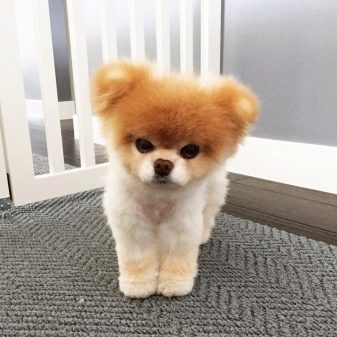

Unfortunately, in addition to the advantages of maintaining the breed described, many owners of bear-type oranges note a small number of shortcomings that may frighten future owners.
- Dwarf cubs are quick-to-excite creatures. They stand on their heels, having heard a strange rustle behind the front door.
- Despite its size, most often dwarf cubs become instigators of fights. They rush at their opponent, try to bite him and always bark. At the same time, mini-bears do not care what dimensions his opponent is endowed with. Accordingly, if the enemy side responds with aggression, then a bilateral conflict cannot be avoided.
- High activity of Pomeranian bears is considered an undoubted advantage, but only when small children live in the house. Otherwise, the pet owner will have to constantly play with the dog, communicate and do everything so that the pet can direct its energy into a peaceful direction. Otherwise, clothing, furniture, wires and any items in its access will suffer.
- Oranges have a fairly loud and very long bark. Pets are started from a half-turn, but it is extremely difficult to calm them down. Without proper education, the animal will become uncontrollable. This indicator is a huge minus when babies live in the house, whose sleep occurs every three hours.
- It is not possible to invite friends or colleagues with whom the dog is not familiar. A small dog, seeing strangers, is able to show aggression.
- The primary and fairly significant factor in the acquisition of a Pomeranian spitz-dog is the cost. The price of thoroughbred puppies from exhibition parents is quite high, and the demand for these animals is much higher than the supply. An inexperienced person may fall for deception and acquire a puppy that just looks like a dwarf bear cub.
Experienced breeders note that unscrupulous sellers put puppies with a poor genetic inheritance on the market, because of which the dog can suffer from various diseases.
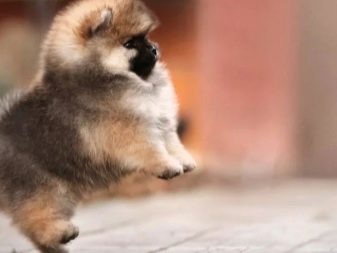
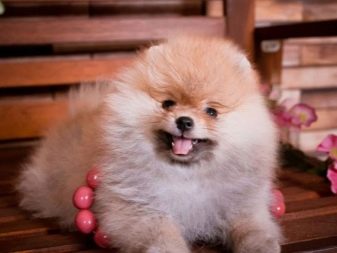
How to choose the right one?
Pomeranian dogs with a bear type of muzzle are very popular and in great demand. The unique image of furry creatures is endowed with a special charm, which is impossible to resist.When purchasing a dwarf bear in his home, the newly-minted owner needs to determine in advance for what purpose he starts the animal. This factor will greatly affect the price of the pet. Besides, A potential buyer needs to ask the seller for a veterinary passport for the puppy being purchased. It should be marked with vaccinations.
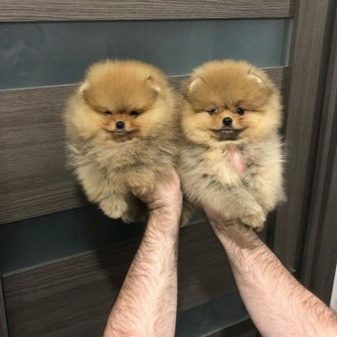
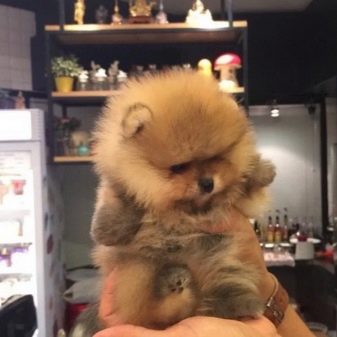
It is important to note that dwarf cubs do not immediately show the distinctive features of their appearance, which is why the animal you like must be reserved for itself, making a small deposit. And already at the age of 4 months, the puppy will begin to show obvious signs of its belonging to the bear subspecies. In this same period, the formation of the muzzle and ears of the dwarf teddy bear begins, which is the hallmark of the breed.

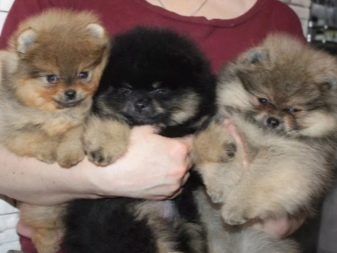
Unfortunately, unscrupulous sellers deceive buyers and sell them ordinary Pomeranian Spitz instead of representatives of a bear type of breed. The buyer should know the main differences between dwarf cubs. The ears of oranges are much larger in size and are protruding on the top of the head, while in the bearish type, the upper parts of the ears are slightly bent to the sides.
In addition to meeting a future pet, it is advisable for the new owner to look at his parents, get acquainted with their pedigree, find out in which exhibition events they participated and, possibly, were prize-winners. In this case, the puppy will not necessarily be similar to its parents. At the genetic level, babies receive only the density of the coat of their ancestors.
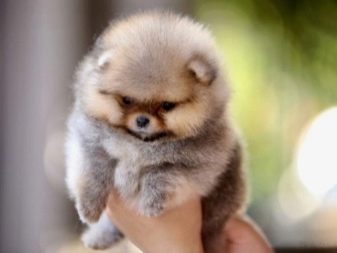
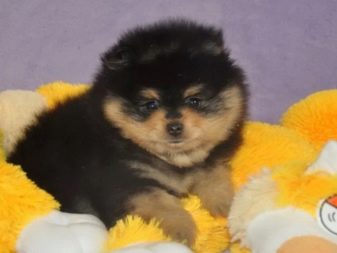
In order not to fall for the tricks of scammers, the future owners of miniature teddy bears need to purchase fluffy handsome men in specialized nurseries with a good reputation. This is exactly how it will be possible at the official level to make a reserve and make a deposit for the animal.
Nurseries also provide the opportunity to visit a potential family member at any time. As a rule, puppies are put up for sale at the age of one and a half months. Accordingly, before the day of purchase, the newly made owners have time to prepare the place of residence and the territory of the animal itself. You will need to check and close all the cracks where a tiny teddy bear can climb. Hide the wires so that they are cracked, remove all objects from the lower shelves, as they can become a toy.
It is important to hide the bin and the most important thing is to secure the trellised balcony.
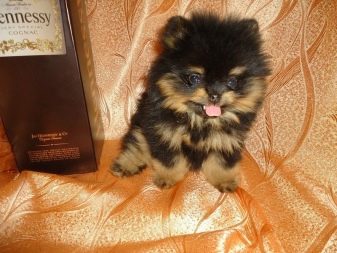
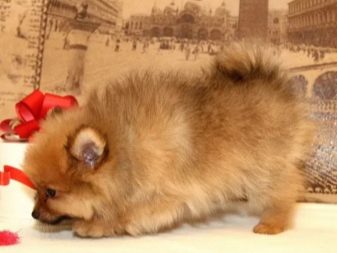
Feeding
The nutrition of bear-type oranges should be balanced, with a sufficient amount of protein, fat and carbohydrates. Moreover, the bulk of the protein elements must be of animal origin. Cubs should receive daily food enriched with vitamins and minerals. The main thing is not to overfeed the baby, each portion should be completely eaten by the pet.
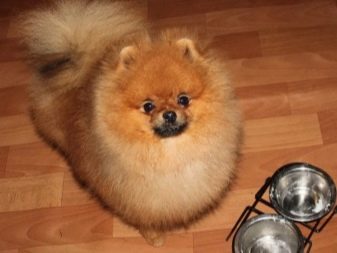
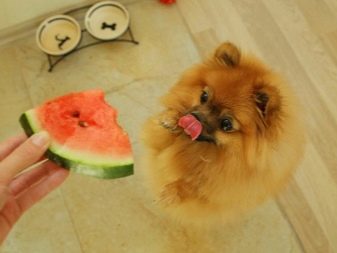
The puppy's nutrition in the new house should correspond to the feeding that the baby is used to living with the breeder. After this, the new owner must decide on the transfer of the dog to another diet or leave the usual feeding for the teddy bear.
When changing the diet, the owner must choose whether to feed the puppy with natural food or prepared foods. At the same time, mixing dry pads with products of a different kind is prohibited. Dry food is balanced and easy to dose. The main thing is that these feeds are premium, and even better super-premium.
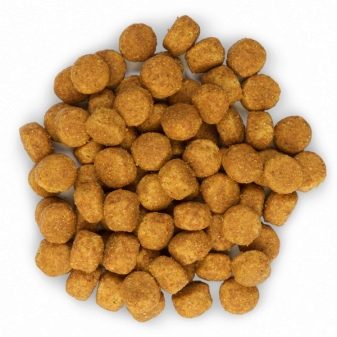
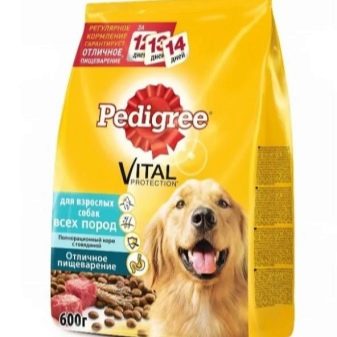
Natural feeding, in turn, complicates the care of the animal. The owner will need to devote a lot of time to prepare food, as products from the table do not always fit the puppy's diet. The menu of the little bear must be made according to an individual plan, where the main ingredient will be meat, fish, cottage cheese and vegetables. Separately, you will have to calculate the daily amount of vitamins and mineral supplements.
In general, the menu of dwarf cubs can be the same, the main thing is that the food is balanced. It is supposed to use beef, mutton of low-fat varieties and chicken as the main ingredient of the natural diet. Due to the large amount of fat, pork does not fit the baby’s delicate stomach. It is important to cut the meat into small pieces and give the pet boiled or raw.
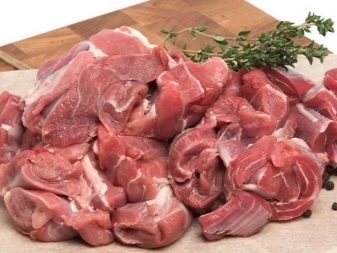

Do not forget about cereals, which should be 10% of the daily diet of the dog, for example, it can be buckwheat or oatmeal. Fish is given to cubs twice a week, while meat is excluded these days. In addition, miniature dogs love boiled eggs and sour-milk products. Vegetable dishes should be fresh, so the owner of the pet will have to cook food before feeding. New foods introduced into the puppy's diet should be included gradually.
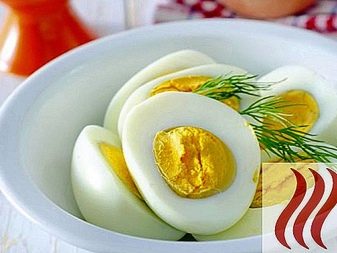
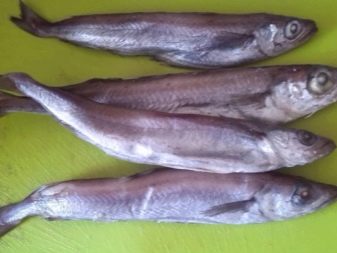
It is strictly forbidden to accustom a dog to products from a harmful list, namely sweet, flour, salty and smoked. The puppy should not be given legumes, semolina, pearl barley and wheat porridge.
When choosing ready-made feeds, the newfound owner should be especially careful. Do not believe commercials that talk about high-quality and indispensable animal feeds. When buying, you must carefully read the composition of the dry pieces.
If the packaging indicates the presence of meat products, their full enumeration should be present nearby, and in the first place the main component, used in large quantities, is prescribed. The composition of the feed should also contain products of plant origin, vitamins and minerals.


Dry feeds whose packaging indicates the use of dyes, flavors and flavor enhancers should be discarded. These components are most often used in poor-quality nutrition that is harmful to the health of the pet.
Feeding an adult is much easier than with puppies. Cooked food can be stretched for several days, only preheat it to room temperature. Dry food does not need to be heated, it is simply poured into a dog bowl. The number of feedings of adult cubs is twice a day.
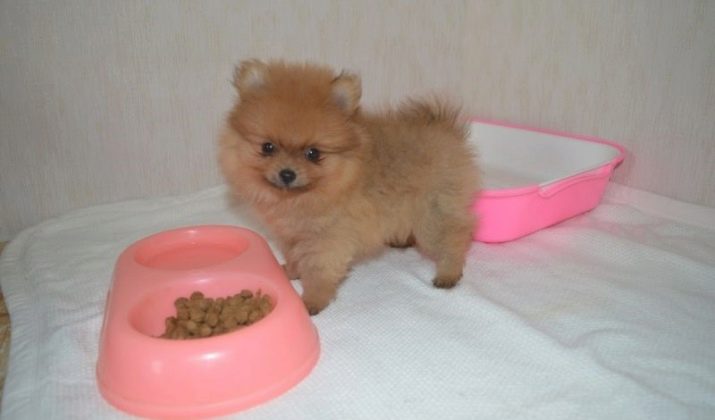
Care
Distinctive features of Pomeranian spitz-dogs of a bear type are a rounded muzzle and charming wool. At first glance, it might seem that caring for a fur coat of miniature bears is difficult, but this opinion is erroneous. Enough to scratch the dog 2 times per week, while paying special attention to the area of the ears, where the cones most often form. It is necessary to comb the animal only against wool, using a moisturizing conditioner, due to which it will be possible to get rid of dead hair and create the necessary volume.
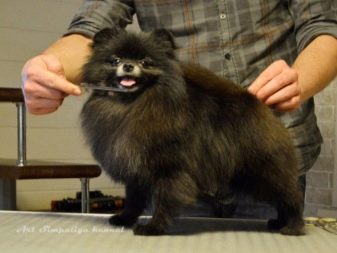
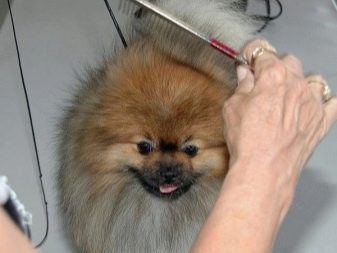
Incidentally, stroking the dog is also necessary against the coat.
The procedure for bathing dwarf cubs should be carried out at most 2 times a month, using a special shampoo for long hair. As an additional cosmetic product, it is better to purchase air conditioning. After bathing, it is very important to dry the pet's hair with a hairdryer. For this reason, cubs are taught from an early age to this device.
The clipping procedure of the mini-cubs is carried out once a month.using a special tool - a nail clipper. The claw plates are then processed with a nail file to remove tapering. When caring for a decorative teddy bear, you need to pay special attention to the eyes. Every morning, the eyes should be treated with a cotton pad to get rid of carotid secretions.
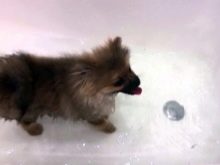

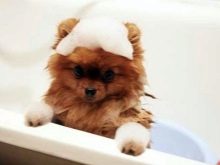
The procedure for cutting hair has several important nuances. It is necessary to shorten the fur coat to a certain length, but so that it does not turn out to be smaller than the undercoat. Short hair can ruin the appearance of a dwarf bear cub. Therefore, before undertaking scissors, the dog owner should take a master class. Otherwise, the dog will be either short-cropped or cut off in pieces.
If the dog’s hairstyle is done on the eve of the exhibition, it’s better to use a professional master, since you won’t be able to do the original styling yourself. A professionally trimmed dog can claim victory.

The procedure for shedding spitz occurs twice a year. At the same time, females molt much more often than males. An important advantage is the fact that during molting, the owner does not have to collect dog hair throughout the house. When falling, it does not get enough sleep, but is in a common pile of hair and is removed with the help of a slicker.
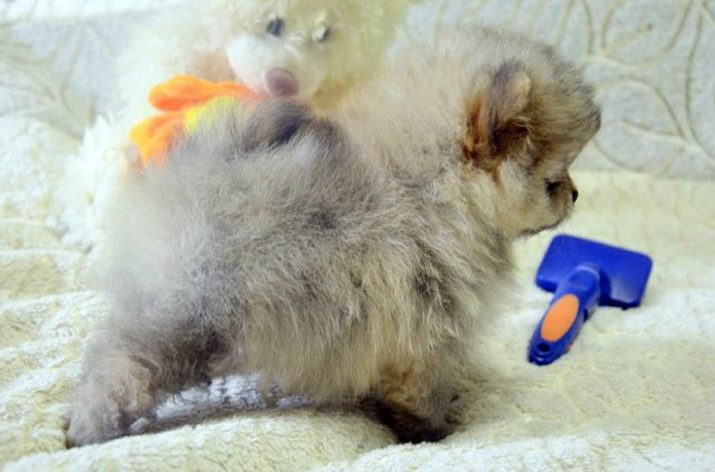
Despite their miniature size, the spitz is of a bear type and has a ton of energy that they have to spend all day. For this reason, walks with animals should proceed with the presence of active games.
With a small puppy, the owner will have to spend at least 5 hours a day on the street. Adults require a two-time walk, each of which should last about an hour or a half. A collar with a leash or harness should be used as a walking accessory. Although the breeders argue that it is best to use a harness, because with a sharp jerk of the leash, the collar can cause injury to the dog’s cervical vertebrae. The harness for the fluffy “ball” should have a rounded shape, so that the probability of rolling the wool under it is minimized.

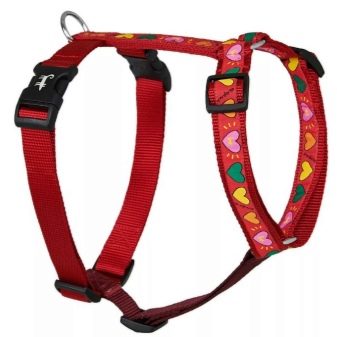
With the onset of cold weather, the bear needs to wear clothes. For autumn and spring, a raincoat will be very handy. Its cut allows you to hide the dog’s stomach and delicate hair from dirt. For winter, insulated jackets or a vest are considered relevant.
A winter suit should not completely cover the body of the animal, otherwise the hair structure will deteriorate, although the Spitz live freely without these accessories. With the arrival of rain and snow, little cubs are advised to wear shoes. Dogs should be accustomed to this accessory from childhood. With their help, it will be possible to avoid the negative effects of chemicals on the paw pads.


The content of Pomeranian cubs only seems complicated at first glance; in fact, all members of a large family can cope with grooming.
Parenting
According to the breeders, Pomeranian dogs are smart and intelligent dwarf dogs. The same applies to all varieties of the breed and their subtypes. With the persistence of the owner and the sequence of actions in education, the little bear cub will very quickly be able to master the necessary commands. In the process of education and training, it is strictly forbidden to give the animal any relief. If the dog notices softness, he will immediately begin to cunning, thereby avoiding training.
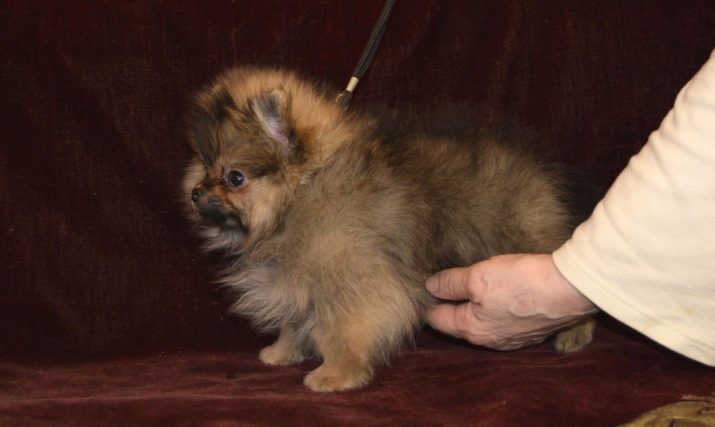
The main friend of the process of training dwarf cubs is the frequency. Raising an animal must be done constantly. Of course, this does not mean that the dog needs to be taken to sports grounds daily and to develop the correct behavior of the pet there. It is enough, if necessary, to demand the execution of commands. For example, if a dog asks for food from the table, a person needs to stop it and do this every time the dog tries to beg for food. Otherwise, all efforts may fail.
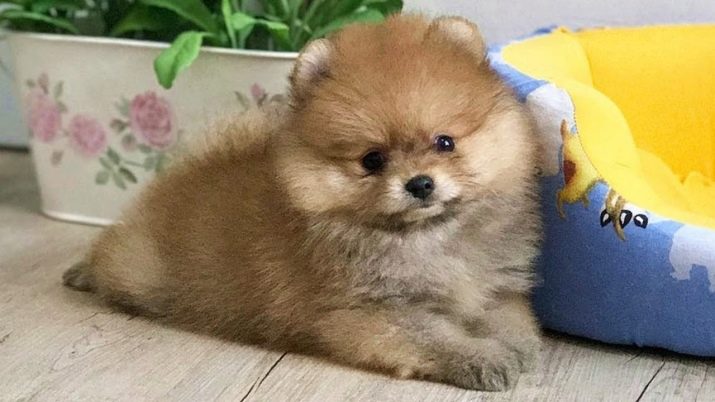
In the process of raising a Pomeranian teddy bear, one should remember its watchdog qualities. They are ready to stand up for their territory by any means possible. In the absence of training, puppies and mature individuals guarding human property may behave badly. Just barking can bring the owner to a nervous breakdown. Therefore, it is important from childhood to wean dwarf dogs from this terrible habit.
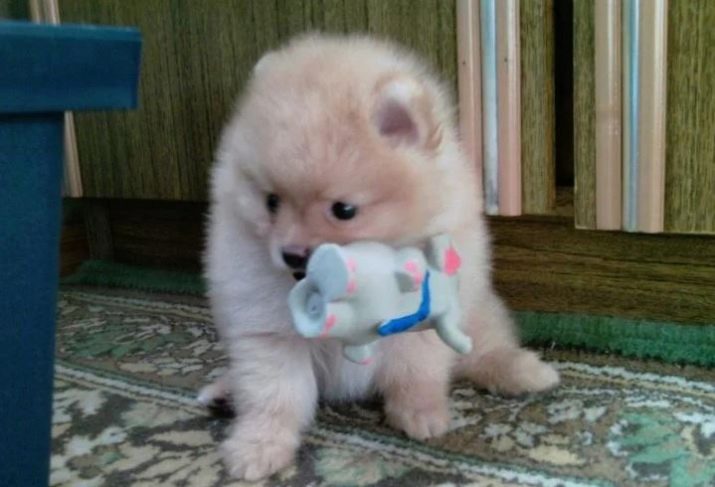
A distinctive feature of the oranges of the teddy bear subtype is the tendency to dominate, which is very difficult to fix, but still possible.
See below for more details.
